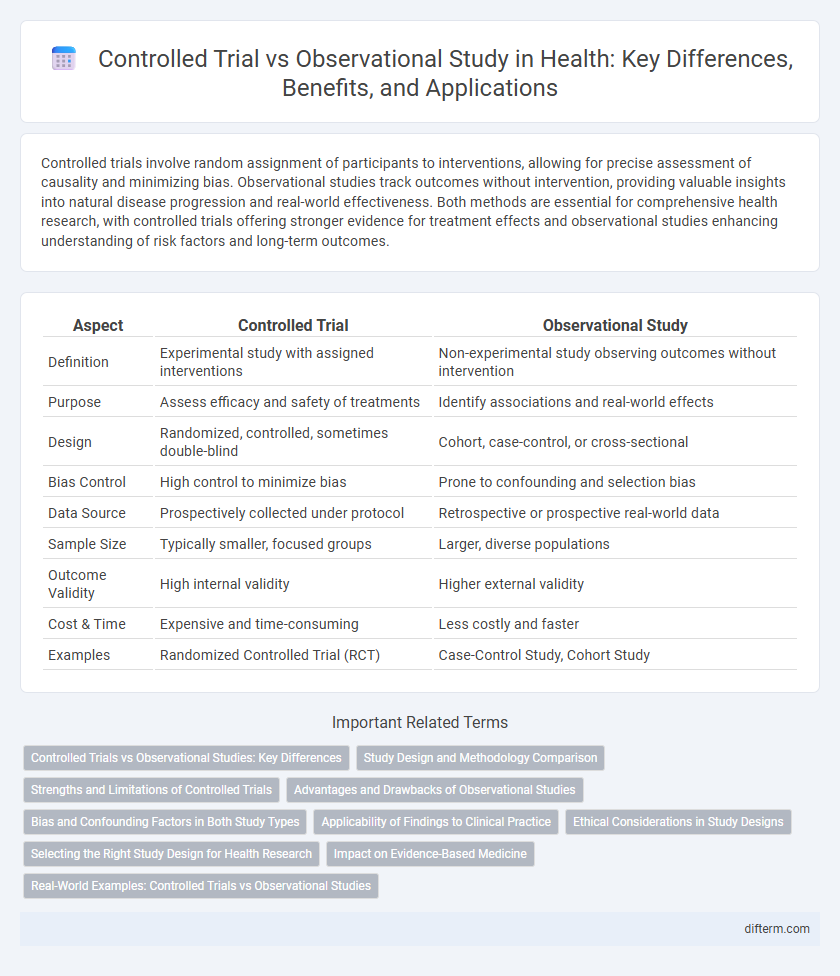Controlled trials involve random assignment of participants to interventions, allowing for precise assessment of causality and minimizing bias. Observational studies track outcomes without intervention, providing valuable insights into natural disease progression and real-world effectiveness. Both methods are essential for comprehensive health research, with controlled trials offering stronger evidence for treatment effects and observational studies enhancing understanding of risk factors and long-term outcomes.
Table of Comparison
| Aspect | Controlled Trial | Observational Study |
|---|---|---|
| Definition | Experimental study with assigned interventions | Non-experimental study observing outcomes without intervention |
| Purpose | Assess efficacy and safety of treatments | Identify associations and real-world effects |
| Design | Randomized, controlled, sometimes double-blind | Cohort, case-control, or cross-sectional |
| Bias Control | High control to minimize bias | Prone to confounding and selection bias |
| Data Source | Prospectively collected under protocol | Retrospective or prospective real-world data |
| Sample Size | Typically smaller, focused groups | Larger, diverse populations |
| Outcome Validity | High internal validity | Higher external validity |
| Cost & Time | Expensive and time-consuming | Less costly and faster |
| Examples | Randomized Controlled Trial (RCT) | Case-Control Study, Cohort Study |
Controlled Trials vs Observational Studies: Key Differences
Controlled trials involve random assignment of participants to intervention or control groups, ensuring high internal validity and minimizing bias. Observational studies monitor outcomes without interference, often used when randomization is unethical or impractical, but they carry a higher risk of confounding variables. Key differences include the level of control over variables, ability to infer causality, and susceptibility to bias, with controlled trials generally considered the gold standard in clinical research.
Study Design and Methodology Comparison
Controlled trials employ randomization and blinding to minimize bias and establish causality, utilizing intervention and control groups under strict protocols. Observational studies analyze naturally occurring exposures without intervention, relying on cohort, case-control, or cross-sectional designs to identify associations. The rigorous methodology of controlled trials provides stronger evidence of cause-effect relationships, while observational studies offer insights in real-world settings where randomization is impractical.
Strengths and Limitations of Controlled Trials
Controlled trials offer high internal validity by randomly assigning participants to intervention or control groups, minimizing selection bias and confounding variables. Their limitations include high costs, ethical constraints, and limited generalizability due to controlled environments and strict eligibility criteria. These trials provide robust evidence of causality but may not fully represent diverse real-world populations.
Advantages and Drawbacks of Observational Studies
Observational studies offer the advantage of capturing real-world data without intervention, providing insights into natural disease progression and outcomes across diverse populations. However, they are prone to confounding variables and bias, limiting the ability to establish causality compared to controlled trials. Despite these drawbacks, observational studies remain crucial for studying rare events and long-term effects when controlled trials are impractical or unethical.
Bias and Confounding Factors in Both Study Types
Controlled trials minimize bias and confounding factors through randomization and controlled environments, ensuring more reliable causal inferences between interventions and outcomes. Observational studies, however, are more susceptible to selection bias and unmeasured confounding variables, which can distort associations and reduce validity. Advanced statistical methods like propensity score matching are often necessary in observational studies to adjust for confounders and approximate the rigor of controlled trials.
Applicability of Findings to Clinical Practice
Controlled trials provide high internal validity by minimizing confounding variables, ensuring that interventions' effects are clearly attributable to the treatment. Observational studies offer greater external validity by reflecting real-world patient populations and clinical settings, enhancing the generalizability of findings to everyday practice. Clinicians often integrate controlled trial outcomes with observational data to make informed decisions that balance efficacy and applicability in diverse patient groups.
Ethical Considerations in Study Designs
Controlled trials require strict ethical oversight to ensure participant safety and informed consent, minimizing risks through randomized interventions. Observational studies often pose fewer ethical challenges since they do not manipulate variables but rely on natural exposure and retrospective data collection. Both designs must prioritize confidentiality and unbiased reporting to uphold ethical standards in health research.
Selecting the Right Study Design for Health Research
Controlled trials offer higher internal validity by randomly assigning participants to interventions, minimizing bias and confounding variables. Observational studies provide valuable insights into real-world health outcomes and are essential when randomization is impractical or unethical. Choosing between controlled trials and observational studies depends on research objectives, ethical considerations, and resource availability to ensure robust and applicable health findings.
Impact on Evidence-Based Medicine
Controlled trials, especially randomized controlled trials (RCTs), provide high-quality evidence by minimizing biases and establishing causality, which strongly influences clinical guidelines and treatment decisions. Observational studies contribute valuable real-world data and help identify associations and potential risk factors when RCTs are impractical or unethical, complementing evidence-based medicine. Combining insights from both study types enhances the robustness and applicability of medical evidence, improving patient outcomes and healthcare policies.
Real-World Examples: Controlled Trials vs Observational Studies
Controlled trials like the Women's Health Initiative provide robust, randomized data on hormone replacement therapy's effects, demonstrating clear cause-effect relationships. Observational studies, such as the Framingham Heart Study, track large populations over time, revealing associations between lifestyle factors and cardiovascular risk without intervention. Real-world examples highlight controlled trials' strength in testing treatments versus observational studies' role in understanding risk factors and disease progression.
controlled trial vs observational study Infographic

 difterm.com
difterm.com